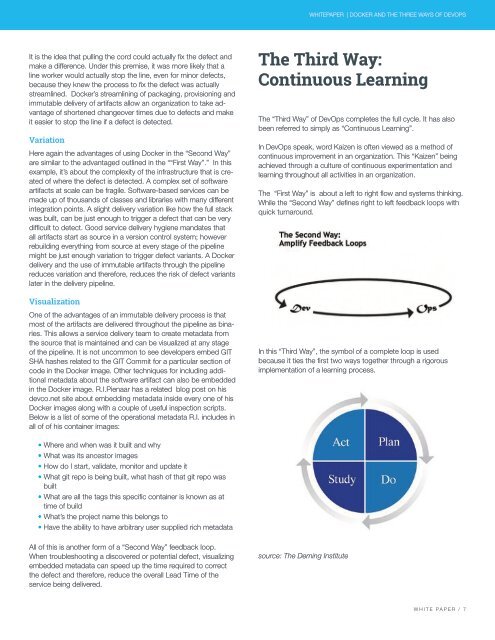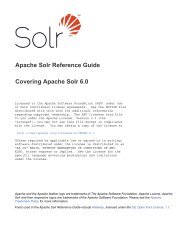Docker and the Three Ways of DevOps
Xks9iQ
Xks9iQ
Create successful ePaper yourself
Turn your PDF publications into a flip-book with our unique Google optimized e-Paper software.
WHITEPAPER | DOCKER AND THE THREE WAYS OF DEVOPS<br />
It is <strong>the</strong> idea that pulling <strong>the</strong> cord could actually fix <strong>the</strong> defect <strong>and</strong><br />
make a difference. Under this premise, it was more likely that a<br />
line worker would actually stop <strong>the</strong> line, even for minor defects,<br />
because <strong>the</strong>y knew <strong>the</strong> process to fix <strong>the</strong> defect was actually<br />
streamlined. <strong>Docker</strong>’s streamlining <strong>of</strong> packaging, provisioning <strong>and</strong><br />
immutable delivery <strong>of</strong> artifacts allow an organization to take advantage<br />
<strong>of</strong> shortened changeover times due to defects <strong>and</strong> make<br />
it easier to stop <strong>the</strong> line if a defect is detected.<br />
Variation<br />
Here again <strong>the</strong> advantages <strong>of</strong> using <strong>Docker</strong> in <strong>the</strong> “Second Way”<br />
are similar to <strong>the</strong> advantaged outlined in <strong>the</strong> ““First Way”.” In this<br />
example, it’s about <strong>the</strong> complexity <strong>of</strong> <strong>the</strong> infrastructure that is created<br />
<strong>of</strong> where <strong>the</strong> defect is detected. A complex set <strong>of</strong> s<strong>of</strong>tware<br />
artifacts at scale can be fragile. S<strong>of</strong>tware-based services can be<br />
made up <strong>of</strong> thous<strong>and</strong>s <strong>of</strong> classes <strong>and</strong> libraries with many different<br />
integration points. A slight delivery variation like how <strong>the</strong> full stack<br />
was built, can be just enough to trigger a defect that can be very<br />
difficult to detect. Good service delivery hygiene m<strong>and</strong>ates that<br />
all artifacts start as source in a version control system; however<br />
rebuilding everything from source at every stage <strong>of</strong> <strong>the</strong> pipeline<br />
might be just enough variation to trigger defect variants. A <strong>Docker</strong><br />
delivery <strong>and</strong> <strong>the</strong> use <strong>of</strong> immutable artifacts through <strong>the</strong> pipeline<br />
reduces variation <strong>and</strong> <strong>the</strong>refore, reduces <strong>the</strong> risk <strong>of</strong> defect variants<br />
later in <strong>the</strong> delivery pipeline.<br />
The Third Way:<br />
Continuous Learning<br />
The “Third Way” <strong>of</strong> <strong>DevOps</strong> completes <strong>the</strong> full cycle. It has also<br />
been referred to simply as “Continuous Learning”.<br />
In <strong>DevOps</strong> speak, word Kaizen is <strong>of</strong>ten viewed as a method <strong>of</strong><br />
continuous improvement in an organization. This “Kaizen” being<br />
achieved through a culture <strong>of</strong> continuous experimentation <strong>and</strong><br />
learning throughout all activities in an organization.<br />
The “First Way” is about a left to right flow <strong>and</strong> systems thinking.<br />
While <strong>the</strong> “Second Way” defines right to left feedback loops with<br />
quick turnaround.<br />
Visualization<br />
One <strong>of</strong> <strong>the</strong> advantages <strong>of</strong> an immutable delivery process is that<br />
most <strong>of</strong> <strong>the</strong> artifacts are delivered throughout <strong>the</strong> pipeline as binaries.<br />
This allows a service delivery team to create metadata from<br />
<strong>the</strong> source that is maintained <strong>and</strong> can be visualized at any stage<br />
<strong>of</strong> <strong>the</strong> pipeline. It is not uncommon to see developers embed GIT<br />
SHA hashes related to <strong>the</strong> GIT Commit for a particular section <strong>of</strong><br />
code in <strong>the</strong> <strong>Docker</strong> image. O<strong>the</strong>r techniques for including additional<br />
metadata about <strong>the</strong> s<strong>of</strong>tware artifact can also be embedded<br />
in <strong>the</strong> <strong>Docker</strong> image. R.I.Pienaar has a related blog post on his<br />
devco.net site about embedding metadata inside every one <strong>of</strong> his<br />
<strong>Docker</strong> images along with a couple <strong>of</strong> useful inspection scripts.<br />
Below is a list <strong>of</strong> some <strong>of</strong> <strong>the</strong> operational metadata R.I. includes in<br />
all <strong>of</strong> <strong>of</strong> his container images:<br />
In this “Third Way”, <strong>the</strong> symbol <strong>of</strong> a complete loop is used<br />
because it ties <strong>the</strong> first two ways toge<strong>the</strong>r through a rigorous<br />
implementation <strong>of</strong> a learning process.<br />
• Where <strong>and</strong> when was it built <strong>and</strong> why<br />
• What was its ancestor images<br />
• How do I start, validate, monitor <strong>and</strong> update it<br />
• What git repo is being built, what hash <strong>of</strong> that git repo was<br />
built<br />
• What are all <strong>the</strong> tags this specific container is known as at<br />
time <strong>of</strong> build<br />
• What’s <strong>the</strong> project name this belongs to<br />
• Have <strong>the</strong> ability to have arbitrary user supplied rich metadata<br />
All <strong>of</strong> this is ano<strong>the</strong>r form <strong>of</strong> a “Second Way” feedback loop.<br />
When troubleshooting a discovered or potential defect, visualizing<br />
embedded metadata can speed up <strong>the</strong> time required to correct<br />
<strong>the</strong> defect <strong>and</strong> <strong>the</strong>refore, reduce <strong>the</strong> overall Lead Time <strong>of</strong> <strong>the</strong><br />
service being delivered.<br />
source: The Deming Institute<br />
WHITE PAPER / 7




